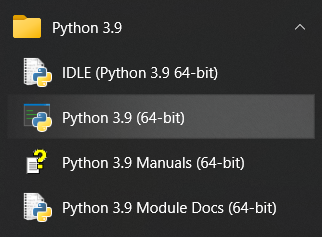Interacting with Python Interpreter
It’s time to write some Python code!
Sturtz [Stuc]
In short there are three major ways to do something with Python:
Using Python interpreter interactively
Using REPL environment is the most straight forward way to start talking to Python. This simply means starting up the interpreter and typing commands to it directly [Stuc]. The interpreter:
Reads the command you enter
Evaluates and executes it
Prints the output (if any) back to the console
Loops back and repeats
Starting the interpreter
In GUI environment, it’s likely that the installer placed a shortcut on the desktop to launch the Python.
For example in Windows the interpreter can be found in the Start menu labeled Python 3.x:

Windows start menu Python group
Hint
In case you are getting error saying python is not installed, but you
are sure that the interpreter is installed - this means you have
no Python in your PATH. Message may look like:
'python' is not recognized as an internal or external command /
python: command not found
Refer Issue - System Environment PATH for problem solution.
The alternative is to launch from a terminal window:
Command Prompt in Windows
Terminal both in macOS and Linux

Start Python via Command Prompt

Start Python via Terminal
Running code
Put the Python code in interactive console and press enter to execute it.
Ensure that the
>>>prompt is displayed and the cursor is pointed after itType the command
print("Hello, World!")Press enter
print("Hello, World!")
Your session should look like:
print("Hello, World!")
"Hello, World!"
If you’ve seen string “Hello, World!” printed back, congrats - you’ve run your first program in Python.
Exiting the interpreter
To exit the interactive console type “exit” and hit enter.
exit()
Running code from file
A Python script is a reusable set of code. It is essentially a Python program - a sequence of Python instructions - contained in a file. You can run the program by specifying the name of the script file to the interpreter.
Python scripts are just plain text, so you can edit them with any text editor. If you have a favorite programmer’s editor that operates on text files, it should be fine to use. Otherwise here are some options for the first time:
Using whatever editor create a script file called hello.py and put the code
in it:
print("Hello, World!")
Save file keeping track on the directory you choose to save into. Now, open the terminal or command prompt in this directory.
Hint
In window you may open Command Prompt in the directory by typing “cmd” to the address bar in explorer.
In the terminal (or command prompt) type:
python hello.py
Python will print string “Hello, World!”. Your session should look like:
python hello.py
Hello, World!